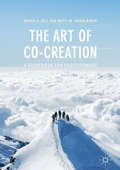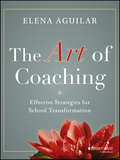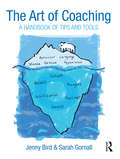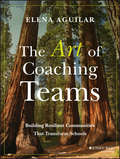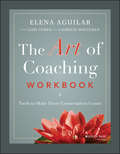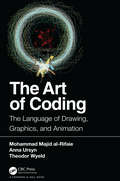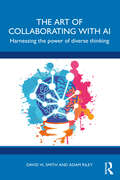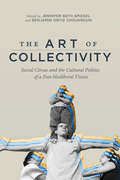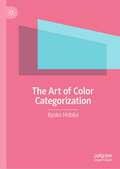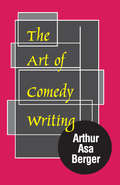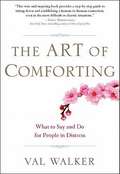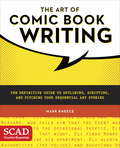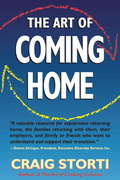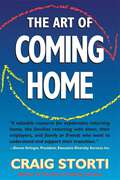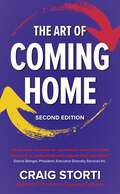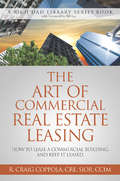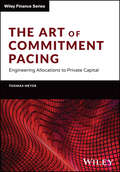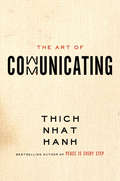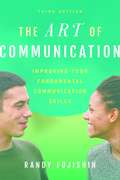- Table View
- List View
The Art of Co-Creation: A Guidebook For Practitioners
by Bryan R. Rill Matti M. HämäläinenThis book illustrates how to design and implement co-creation, a powerful form of collective creativity that harnesses the potential of teams and can generate breakthrough insights. Skilled leaders and facilitators can utilize this approach to unleash the creative potential of their organizations. Drawing from years of applied research, the authors bring together insights from the fields of design and organizational development into an evocative and pragmatic “how-to” guidebook. Taking a human-centred rather than process oriented perspective, the book argues that experience design separates true co-creation from other forms of collective efforts and design thinking. Collective moments of creative insight emerge from the space between, an experience of flow and synchronicity from which new ideas spring forth. How to create and hold this space is the secret to the art of co-creation. Collective breakthroughs require stakeholders to undergo a journey from the world of their existing expertise into spaces of new potential. It requires leaders moving from a position of dominating space to holding the space for others, and developing core capacities such as empathy and awareness so that teams can engage each other co-creatively. This book uncovers the secrets of this journey, enabling process designers to develop more effective programs.
The Art of Coaching
by Elena AguilarHands-on resources for new and seasoned school coachesThis practical resource offers the foundational skills and tools needed by new coaching educators, as well as presenting an overview of the knowledge and theory base behind the practice. Established coaches will find numerous ways to deepen and refine their coaching practice. Principals and others who incorporate coaching strategies into their work will also find a wealth of resources.Aguilar offers a model for transformational coaching which could be implemented as professional development in schools or districts anywhere. Although she addresses the needs of adult learners, her model maintains a student-centered focus, with a specific lens on addressing equity issues in schools.Offers a practical resource for school coaches, principals, district leaders, and other administratorsPresents a transformational coaching model which addresses systems changePays explicit attention to surfacing and interrupting inequities in schoolsThe Art of Coaching: Effective Strategies for School Transformation offers a compendium of school coaching ideas, the book's explicit, user-friendly structure enhances the ability to access the information.
The Art of Coaching: A Handbook of Tips and Tools
by Sarah Gornall Jenny BirdThe Art of Coaching is a book to shift thinking and open up new possibilities, to stimulate fresh insight, to adapt to your needs as a coach or manager and to use creatively in practice. Written by two experienced, highly qualified international coaches and supervisors, this creative book offers ideas to use across the range of coaching contexts including leadership, decision making, change and supervision. Combining brand-new, original diagrams with classic models from the learning development and management fields, Jenny Bird and Sarah Gornall have a created a valuable resource for quick reference, instant accessibility and fast learning, built on a strong theoretical base. Each model in the book is explained with a clear, accessible diagram and a simple guide to what it is, how it works and how to put it into action. The text is full of inspiration for applications of the ideas in scenarios based on real coaching practice. The Art of Coaching will be an invaluable companion for coaches looking for new ways of developing awareness with clients, coaching students and trainees, coach supervisors, learning and development professionals and those working in human resource departments.
The Art of Coaching Teams
by Elena AguilarThe missing how-to manual for being an effective team leader The Art of Coaching Teams is the manual you never received when you signed on to lead a team. Being a great teacher is one thing, but leading a team, or team development, is an entirely different dynamic. Your successes are public, but so are your failures--and there's no specific rubric or curriculum to give you direction. Team development is an art form, and this book is your how-to guide to doing it effectively. You'll learn the administrative tasks that keep your team on track, and you'll gain access to a wealth of downloadable tools that simplify the "getting organized" process. Just as importantly, you'll explore what it means to be the kind of leader that can bring people together to accomplish difficult tasks. You'll find practical suggestions, tools, and clear instructions for the logistics of team development as well as for building trust, developing healthy communication, and managing conflict. Inside these pages you'll find concrete guidance on: Designing agendas, making decisions, establishing effective protocols, and more Boosting your resilience, understanding and managing your emotions, and meeting your goals Cultivating your team's emotional intelligence and dealing with cynicism Utilizing practical tools to create a customized framework for developing highly effective teams There is no universal formula for building a great team, because every team is different. Different skills, abilities, personalities, and goals make a one-size-fits-all approach ineffective at best. Instead, The Art of Coaching Teams provides a practical framework to help you develop your group as a whole, and keep the team moving toward their common goals.
The Art of Coaching Workbook: Tools to Make Every Conversation Count
by Elena AguilarA practical guide for getting the most out of The Art of Coaching The Art of Coaching Workbook is the resource you’ve been waiting for to accompany Elena Aguilar’s The Art of Coaching. Ideal for new and novice coaches, as well as for those who have years of coaching under their belt, this workbook will help you improve your coaching skills. This vital companion text includes: Dozens of activities to help you internalize the concepts described in The Art of Coaching Exercises to guide you in identifying your own coaching beliefs, style, and practices Short and lengthy transcripts of coaching conversations Additional examples of key concepts in The Art of Coaching, including the Ladder of Inference and the Coaching Lenses New ideas and information that build on those in The Art of Coaching This workbook is also for those who lead and manage coaches. An entire chapter is dedicated to structures, routines, and practices that are easy to implement in professional development sessions. In addition, a new Transformational Coaching Rubric and other tools for assessment and reflection are included. If you aspire to provide meaningful learning for coaches, and you already have The Art of Coaching, this workbook is all you’ll need.
The Art of Coding: The Language of Drawing, Graphics, and Animation
by Mohammad Majid al-Rifaie Anna Ursyn Theodor WyeldAs the title suggests, this book explores the concepts of drawing, graphics and animation in the context of coding. In this endeavour, in addition to initiating the process with some historical perspectives on programming languages, it prides itself by presenting complex concepts in an easy-to-understand fashion for students, artists, hobbyists as well as those interested in computer science, computer graphics, digital media, or interdisciplinary studies. Being able to code requires abstract thinking, mathematics skills, spatial ability, logical thinking, imagination, and creativity. All these abilities can be acquired with practice, and can be mastered by practical exposure to art, music, and literature. This book discusses art, poetry and other forms of writing while pondering difficult concepts in programming; it looks at how we use our senses in the process of learning computing and programming. Features: Introduces coding in a visual way Explores the elegance behind coding and the outcome Includes types of outcomes and options for coding Covers the transition from front-of-classroom instruction to the use of online-streamed video tutorials Encourages abstract and cognitive thinking, as well as creativity The Art of Coding contains a collection of learning projects for students, instructors and teachers to select specific themes from. Problems and projects are aimed at making the learning process entertaining, while also involving social exchange and sharing. This process allows for programming to become interdisciplinary, enabling projects to be co-developed by specialists from different backgrounds, enriching the value of coding and what it can achieve. The authors of this book hail from three different continents, and have several decades of combined experience in academia, education, science and visual arts. Source Code: The source code for the book can be accessed here.
The Art of Collaborating with AI: Harnessing the Power of Diverse Thinking
by David VL Smith Adam RileyWe are at a momentous inflection point in our evolutionary history: generative AI is becoming mainstream, transforming the world of work, and specifically that of knowledge workers. This book helps you to navigate your upskilling journey to remain relevant and to add value in the workplace.Knowledge workers must face up to the fact that there is a need to urgently reboot their skill set to survive and thrive in the new AI era. Many of the historic competences and points of differentiation that employees could offer are being challenged with AI technology. This book is all about building the power skills that knowledge workers will need to develop to maintain a competitive edge and work effectively alongside AI. It’s a future where AI will now do a lot of the heavy lifting and one in which employers will increasingly be looking for people to add value in areas where AI is weak. In particular, this puts the spotlight on the need for workers to dial up their potential as polymaths. These are people who can see the big picture from different perspectives and who can add that extra layer of innovative thinking and creativity to everything they do. Importantly, the book provides a framework for understanding how AI is likely to reshape the fundamental structure of the workforce, and how knowledge workers can strategically position themselves to enhance their value.This book provides an essential guide to developing new skill sets for knowledge workers in the AI era. Not only does it ensure that you don’t fall behind, it will also enable you to succeed and thrive.
The Art of Collectivity: Social Circus and the Cultural Politics of a Post-Neoliberal Vision
by Jennifer Beth Spiegel and Benjamin Ortiz ChoukrounAmidst epidemics of youth alienation and cultural polarization, community-based artistic practices are sprouting up around the world as antidotes to policies of austerity and social exclusion. Rejecting the radical individualism of the neoliberal era, many artistic projects promote collectivity and togetherness in navigating challenges and constructing shared futures. The Art of Collectivity is about how one such creative social program deployed this approach in service of a post-neoliberal vision. Focusing on a national social circus initiative launched by a newly elected Ecuadorean government to help actualize its “citizens' revolution,” the book explores the intersection between global cultural politics, participatory arts, collective health, and social transformation. The authors include scholars and practitioners of community arts, humanities, social sciences, and health sciences from the Global North and Global South. Sensitive to hierarchical binaries such as research/practice, north/south, and art/science, they work together to provide a multifaceted analysis of the way cultural politics shape policy, pedagogy, and aesthetic sensibilities, as well as their socio-cultural and health-related effects. The largest study of social circus to date, combining detailed quantitative, qualitative, and arts-based research, The Art of Collectivity is a timely contribution to the study of cultural policies, critical pedagogies, collective art-making, and community development.
The Art of Collectivity: Social Circus and the Cultural Politics of a Post-Neoliberal Vision
by Jennifer Beth Spiegel Benjamin Ortiz ChoukrounAmidst epidemics of youth alienation and cultural polarization, community-based artistic practices are sprouting up around the world as antidotes to policies of austerity and social exclusion. Rejecting the radical individualism of the neoliberal era, many artistic projects promote collectivity and togetherness in navigating challenges and constructing shared futures. The Art of Collectivity is about how one such creative social program deployed this approach in service of a post-neoliberal vision. Focusing on a national social circus initiative launched by a newly elected Ecuadorean government to help actualize its “citizens' revolution,” the book explores the intersection between global cultural politics, participatory arts, collective health, and social transformation. The authors include scholars and practitioners of community arts, humanities, social sciences, and health sciences from the Global North and Global South. Sensitive to hierarchical binaries such as research/practice, north/south, and art/science, they work together to provide a multifaceted analysis of the way cultural politics shape policy, pedagogy, and aesthetic sensibilities, as well as their socio-cultural and health-related effects. The largest study of social circus to date, combining detailed quantitative, qualitative, and arts-based research, The Art of Collectivity is a timely contribution to the study of cultural policies, critical pedagogies, collective art-making, and community development.
The Art of Color Categorization
by Kyoko HidakaFrom Newton's prism spectroscopy to modern color science, the study of color has been rooted in the categorization of colors. Building upon this foundation, this book aims to explore the rich and varied examples of color theory through two basic concepts: categorizing colors themselves and categorizing things by color. How have different cultures drawn the line between colors, and why? What do these divisions reveal about color naming, standards, environments, and sensory perceptions? The book delves into these questions, shedding light on how color categorization has shaped our world. Through this exploration of color theory, the author also hopes to draw attention to the potential parallels between Western color classifications and the logic of racism. By examining various theories on color classification standards, the author seeks to unravel this complex issue and encourage readers to reflect on how our understanding of color and categorization can impact our social and cultural attitudes.
The Art of Comedy: Getting Serious About Being Funny
by Paul RyanLong-time Hollywood comedy acting coach Ryan explains how to create comedy using such tools as a comedy notebook, sketching a comedy character, and taking improvisation into the written scene. He intersperses exercises progressing from beginning through intermediate to advanced. Annotation ©2007 Book News, Inc. , Portland, OR (booknews. com)
The Art of Comedy Writing
by Arthur Asa BergerJust as a distinctive literary voice or style is marked by the ease with which it can be parodied, so too can specific aspects of humor be unique. Playwrights, television writers, novelists, cartoonists, and film scriptwriters use many special technical devices to create humor. Just as dramatic writers and novelists use specific devices to craft their work, creators of humorous materials from the ancient Greeks to today's stand-up comics have continued to use certain techniques in order to generate humor.In The Art of Comedy Writing, Arthur Asa Berger argues that there are a relatively limited number of techniques forty-five in all that humorists employ. Elaborating upon his prior, in-depth study of humor, An Anatomy of Humor, in which Berger provides a content analysis of humor in all forms joke books, plays, comic books, novels, short stories, comic verse, and essaysThe Art of Comedy Writing goes further. Berger groups each technique into four basic categories: humor involving identity such as burlesque, caricature, mimicry, and stereotype; humor involving logic such as analogy, comparison, and reversal; humor involving language such as puns, wordplay, sarcasm, and satire; and finally, chase, slapstick, and speed, or humor involving action.Berger claims that if you want to know how writers or comedians create humor study and analysis of their humorous works can be immensely insightful. This book is a unique analytical offering for those interested in humor. It provides writers and critics with a sizable repertoire of techniques for use in their own future comic creations. As such, this book will be of interest to people inspired by humor and the creative process professionals in the comedy field and students of creative writing, comedy, literary humor, communications, broadcast/media, and the humanities.
The Art of Comforting
by Val WalkerWe live in an increasingly "virtual" world in which it can be tempting to skip making that true, human connection with someone in pain. Even though our thoughts might be with them, we lack the confidence to reach out, worrying that we will say or do the "wrong" thing. In this practical, step-by-step guide to what she calls "the art of comforting," Val Walker draws on numerous interviews with "Master Comforters" to guide readers in gently and gracefully breaking through the walls that those who are suffering often erect around themselves. Interviewees include inspiring individuals such as Alicia Rasin, who, as a victim's advocate for the city of Richmond, Virginia, has devoted her life to comforting grieving families devastated by homicide, gang violence, and other traumatic experiences; or Patricia Ellen, who, as a grief counselor and outreach director at the Center for Grieving Children in Portland, Maine, appears on site to support and comfort children, staff, and parents when a school is facing a death, violence, or other crises. All of us will, at one time or the other, be called upon to offer warmth and support to another human being who is suffering-this book will show you how to answer the call with an open heart. .
The Art of Comic Book Writing
by Mark KneeceA practical guide for beginner and advanced comic book writers that outlines the steps needed to successfully craft a story for sequential art. With this latest book in the SCAD Creative Essentials series from the esteemed Savannah College of Art and Design, comics writer and instructor Mark Kneece gives aspiring comic book writers the essential tools they need to write scripts for sequential art with confidence and success. He provides a practical set of guidelines favored by many comic book publishers and uses a unique trial and error approach to show would-be scribes the potential pitfalls they might encounter when seeking a career in comics writing. Supported by examples of scripting from SCAD's students, faculty, and alumni,The Art of Comic Book Writing strips away the mysteries of this popular artform and provides real-world advice and easy-to-follow examples for those looking to write for the comics medium.
The Art of Comics: A Philosophical Approach (New Directions in Aesthetics #32)
by Aaron Meskin Roy T. CookThe Art of Comics is the first-ever collection of essays published in English devoted to the philosophical topics raised by comics and graphic novels. In an area of growing philosophical interest, this volume constitutes a great leap forward in the development of this fast expanding field, and makes a powerful contribution to the philosophy of art. The first-ever anthology to address the philosophical issues raised by the art of comics Provides an extensive and thorough introduction to the field, and to comics more generally Responds to the increasing philosophical interest in comic art Includes a preface by the renowned comics author Warren Ellis Many of the chapters are illustrated, and the book carries a stunning cover by the rising young comics star David Heatley
The Art of Coming Home
by Craig StortiExpecting that the home will be the way it was when you left? Are you instead shocked to discover that both you and home have changed? The Art of Coming Home offers the solid advice you need to reduce the stress of making the transition home. Leave-taking, the honeymoon stage, reverse culture shock, and eventual readjustment--The Art of Coming Home lays out the four stages of the reentry process and details practical strategies for dealing with the challenges you will face each step of the way. Veteran trainer, consultant, and world adventurer Craig Storti sketches the workplace challenges faced by returning business executives as well as the reentry issues of spouses, younger children, and teenagers. He also addresses in detail the special issues faced by exchange students, international volunteers, military personnel and their families, and missionaries and their children. Whether you are a recent returnee or are just now thinking of moving abroad, The Art of Coming Home sets itself apart as it brings the process of returning home right to the heart of the overseas experience.
The Art of Coming Home
by Craig StortiExpecting that the home will be the way it was when you left? Are you instead shocked to discover that both you and home have changed? The Art of Coming Home offers the solid advice you need to reduce the stress of making the transition home. Leave-taking, the honeymoon stage, reverse culture shock, and eventual readjustment - The Art of Coming Home lays out the four stages of the reentry process and details practical strategies for dealing with the challenges you will face each step of the way. Veteran trainer, consultant, and world adventurer Craig Storti sketches the workplace challenges faced by returning business executives as well as the reentry issues of spouses, younger children, and teenagers. He also addresses in detail the special issues faced by exchange students, international volunteers, military personnel and their families, and missionaries and their children. Whether you are a recent returnee or are just now thinking of moving abroad, The Art of Coming Home sets itself apart as it brings the process of returning home right to the heart of the overseas experience.
The Art of Coming Home
by Craig StortiUpdated 2nd Edition!If you were lucky, you knew about and were prepared for culture shock when you moved overseas, but unless you are very lucky, you probably don&’t know about and are not prepared for reverse culture shock. And you should be. Most expats find coming home after an overseas assignment more difficult than adjusting to a foreign culture—and very few organizations and companies prepare people for the experience.Veteran trainer and consultant Craig Storti sketches the workplace challenges faced by returning businessmen and women as well as the re-entry issues of spouses, younger children, and teenagers. He also addresses in detail the special issues faced by exchange students, international development volunteers, and military and missionary personnel and their families.If you&’re about to relocate abroad, are already living abroad, about to come home, or already home, this book walks you through the biggest adjustments, personal and professional, and in this new edition presents a complete do-it-yourself repatriation workshop to help you identify and address your individual readjustment issues.
The Art of Coming Home
by Craig StortiIf you were lucky, you knew about and were prepared for culture shock when you moved overseas, But unless you are very lucky, you probably don't know about and are not prepared for reverse culture shock. And you should be. Most expats find coming home after an overseas assignment more difficult than adjusting to a foreign culture-and very few organizations and companies prepare people for the experience.Veteran trainer and consultant Craig Storti sketches the workplace challenges faced by returning businessmen and women as well as the re-entry issues of spouses, younger children, and teenagers. He also addresses in detail the special issues faced by exchange students, international development volunteers, and military and missionary personnel and their families.From leave-taking and the honeymoon stage through to reverse culture shock and eventual readjustment, The Art of Coming Home lays out the four stages of the re-entry process and details practical strategies for dealing with the challenges you will face each step of the way.Whether you're about to relocate abroad, are already living abroad, about to come home, or already home, this book walks you through the biggest adjustments, personal and professional, and in this new edition presents a complete do-it-yourself repatriation workshop to help you identify and address your individual readjustment issues.
The Art Of Commercial Real Estate Leasing
by R. Craig CoppolaWhy wait another day? Make the most of your commercial property.A commercial building is just a building; but, it's an investment once it's leased with positive cash flow. Sounds easy? It's not. To invest and lease right you need the help of an expert who has spent his professional life as a commercial real estate broker and investor. You need the decades-long master of commercial real estate on your side. You need Craig Coppola.Before you make your next commercial real estate investment move, read this book. In it you'll find Craig's wisdom, insights and how-to's - the very techniques he uses to maximize his clients' and his own investments. Thinking of taking on leasing by yourself? This book will guide you. Considering hiring a broker to represent your properties? This book will make you a better buyer of those services. It's fast, easy, indispensable!
The Art of Commitment Pacing: Engineering Allocations to Private Capital (The Wiley Finance Series)
by Thomas MeyerAdvanced guidance for institutional investors, academics, and researchers on how to manage a portfolio of private capital funds The Art of Commitment Pacing: Engineering Allocations to Private Capital provides a much-needed analysis of the issues that face investors as they incorporate closed ended-funds targeting illiquid private assets (such as private equity, private debt, infrastructure, real estate) into their portfolios. These private capital funds, once considered "alternative" and viewed as experimental, are becoming an increasingly standard component of institutional asset allocations. However, many investors still follow management approaches that remain anchored in the portfolio theory for liquid assets but that often lead to disappointing results when applied to portfolios of private capital funds where practically investors remain committed over nearly a decade. When planning for such commitments, investment managers and researchers are faced with practical questions such as: How to measure and control the real exposure to private assets? How to forecast cash-flows for commitments to private capital funds? What ranges for their returns and lifetime are realistic, and how can the investor’s skill be factored in? Over which dimensions should a portfolio be diversified and how much diversification is enough? How can the impact of co-investments or secondaries be modelled? How to design pacing plans that lead to resilient and efficient portfolios? What stress scenarios should be considered and how can they be applied? These are just examples of the many questions for which answers are provided. The Art of Commitment Pacing describes established and new methodologies for building up and controlling allocations to such investments. This book offers a systematic approach for building up and controlling allocations to such investments. The Art of Commitment Pacing is a valuable addition to the libraries of investment managers, as well as portfolio and risk managers involved in institutional investment. The book will also be of interest to advanced students of finance, researchers, and other practitioners who require a detailed understanding of forecasting and portfolio management methodologies.
The Art of Communicating
by Thich Nhat HanhZen master Thick Nhat Hanh, bestselling author of Peace is Every Step and one of the most respected and celebrated religious leaders in the world, delivers a powerful path to happiness through mastering lifes most important skill. How do we say what we mean in a way that the other person can really hear?How can we listen with compassion and understanding?Communication fuels the ties that bind, whether in relationships, business, or everyday interactions. Most of us, however, have never been taught the fundamental skills of communication--or how to best represent our true selves. Effective communication is as important to our well-being and happiness as the food we put into our bodies. It can be either healthy (and nourishing) or toxic (and destructive). In this precise and practical guide, Zen master and Buddhist monk Thick Nhat Hanh reveals how to listen mindfully and express your fullest and most authentic self. With examples from his work with couples, families, and international conflicts, The Art of Communicating helps us move beyond the perils and frustrations of misrepresentation and misunderstanding to learn the listening and speaking skills that will forever change how we experience and impact the world.
The Art of Communication: How to be Authentic, Lead Others, and Create Strong Connections
by Judy AppsBring nuance, depth, and meaning to every conversation you have The Art of Communication is for anyone who senses that they could be communicating on a deeper level. Perhaps you are a confident communicator but suspect there may be more to the art of conversation that you have not yet been able to access. Or perhaps you feel that your conversations lack depth and meaning and that you’d like to enrich your relationships with others, if only you knew how. This book will address your concerns and show you how to engage wholeheartedly with others. There’s more to conversation than just clear, rational thinking. Left-brain rationality is important, of course, but neuroscience increasingly shows that the right-brain skills of creativity, intuition and spontaneity are essential in good communication. In this guide, you’ll discover ways of tapping into the full conversational potential that lies dormant within you, adding a level of nuance and watching the result as your relationships blossom. You may even find that untapped value in the form of new insights, ideas and creative thoughts, emerges from your daily conversations. Access the more nuanced arts of conversation to create strong connections and tangible results Build cross-disciplinary, cross-cultural connections to communicate effectively with people from different backgrounds Activate your whole mind — not just your intellect — to bring creativity and depth to communication Learn to be open-hearted, spontaneous, vulnerable, intuitive, and captivating in every conversation you hold From communication guru and bestselling author Judy Apps, The Art of Communication will show you how to breathe life into your relationships and produce powerful new thinking enabling you to transform the world you live in.
The Art Of Communication: Improving Your Fundamental Communication Skills (Third Edition)
by Randy FujishinThis third edition of The Art of Communication (previously titled Creating Communication) is a brief and practical introduction to speech communication. Emphasizing face-to-face communication, yet also addressing the role of technology and its influence on daily communication, Fujishin helps you develop greater understanding of how important communication skills are in your personal and professional life--and will inspire you to use these skills in ways that enlarge and improve the lives of others as well as your own. Fujishin employs a distinctively encouraging and conversational approach as he explains the basic communication skills necessary to improve in numerous contexts--including public speaking, small group, interpersonal, intercultural, leadership, interviewing, and technology-based communication. The result is an easy-to-read book that provides the tools to implement powerful changes in the ways you interact with others.
The Art of Communication: Semiotic Foundations and Strategic Applications (ISTE Invoiced)
by Peter StockingerThe Art of Communication combines over two decades of research and teaching into a comprehensive guide on strategic communication. Grounded in the theoretical and methodological frameworks of 'situated communication' and 'communication project', this book highlights an understanding of both traditional and emerging communication practices. It particularly focuses on new genres, such as branding, design and digital communication strategies, and introduces the innovative concept of 'textscapes' – specially crafted environments to fulfill communicative objectives. This book is enriched with practical examples and is particularly relevant in multicultural and international settings, providing essential insights for adapting communication strategies to diverse cultural contexts.
